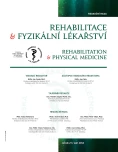Shoulder in Epitome – First Part
Authors:
P. Michalíček 1; J. Vacek 2
Authors‘ workplace:
2. Klinika rehabilitačního lékařství 3. LF UK a FNKV IPVZ, Praha
; 1. Vojenský rehabilitační ústav Slapy nad Vltavou, Slapy nad Vltavou, ředitel a primář MUDr. M. Kubíček, Ph. D, MBA
Published in:
Rehabil. fyz. Lék., 21, 2014, No. 3, pp. 151-162.
Category:
Original Papers
Overview
The aim of the article is to clarify and illustrate the often unclear issue of the broad area of shoulder pain. The article consists of three parts. This first part refers to basic important phylogenetic connections between shoulder functional development and the current kinesiological knowledge of shoulder biomechanics that lead to understanding the origin of the aching functional and subsequently also structural disability in shoulder joint girdle. The second part introduces the most frequent and best known clinical symptoms of these shoulder disorders. It offers simple classification of shoulder aches according to etiology, type and extent of the injured tissues and it clarifies non-specific transmitted shoulder aches. The third closing part of the article is devoted to the general aim and basic strategy of aching shoulder medical rehabilitation, including specific examples of known and tested, as well as the latest therapeutic procedures and methods. Principles and advantages of their use in rehabilitation are emphasized.
Keywords:
biomechanics, static and dynamic stabilizers of the shoulder joint, scapulo humeral rhythm, rotator cuff, shoulder abduction stereotype, muscular loops
Sources
1. BAČÁKOVÁ, R., DUFKOVÁ, A., KRAČMAR, B.: Aktivace musculus latissimus dorsi při práci horní končetiny. Rehabilitace a fyzikální lékařství, 15, 2008, s. 110-113.
2. BARTONÍČEK, J.: Chirurgická anatomie velkých končetinových kloubů. Praha, Avicenum, 1991.
3. BASMAJIAN, J. V., DE LUCA, C. J.: Muscles alive: Their functions revealed by electromyography. Baltimore, Maryland, Williams & Wilkins, 1985.
4. BASTLOVÁ, P., KROBOT, A., MÍKOVÁ, M. et al.: Strategie rehabilitace po frakturách proximálního humeru. Rehabilitace a fyzikální lékařství, 11, 2004, s. 3-18.
5. BEALL, D. P.: Association of biceps tendon tears with rotator cuff abnormalities: Degree of correlation with tears of the anterior and superior portions of the rotator cuff. American Journal of Roentgenology, 180, 2003, s. 633-639.
6. CAMPBELL, B.: Human evolution: An introduction to man´s adaptations. New York, Aldine De Gruyter, 1998.
7. DUNGL, P. et al.: Ortopedie. Praha, Grada Publishing, 2005.
8. DYLEVSKÝ, I.: Obecná kineziologie. Praha, Grada Publishing, 2007.
9. HAMILL, J., KNUTZEN, K. M.: Biomechanical basis of human movement. Baltimore, Lippincott Williams and Wilkins, 1995.
10. JANDA, V.: Svalové funkční testy. Praha, Grada, 2004.
11. JANURA, M., MÍKOVÁ, M., KROBOT, A., JANUROVÁ, E.: Ramenní pletenec z pohledu klasické biomechaniky. Rehabilitace a fyzikální lékařství, 11, 2004, s. 33-39.
12. KAPANDJI, A. I.: The physiology of the joints volume one: Upper limb. Edinburgh, Churchill Livingstone Elsevier, 2005.
13. KROBOT, A., MÍKOVÁ, M., BASTLOVÁ, P.: Poznámky k vývojovým aspektům rehabilitace poruch ramene. Rehabilitace a fyzikální lékařství, 11, 2004, s. 88-94.
14. KROBOT, A.: Variabilita tvaru lopatky a predikce pohybových poruch ramene. Rehabilitace a fyzikální lékařství, 11, 2004, s. 67-81.
15. KROBOT, A.: Rehabilitace ramenního pletence u hemiparetických nemocných. Neurologie pro praxi, 2005, 6, s. 296-301.
16. LEAR, L. J., GROSS, M. T.: An electromyographical analysis of the scapular stabilizing synergists during a push-up progression. Journal of Orthopaedic & Sports Physical Therapy, 28, 1998, s. 146-157.
17. LEWIS, A., KITAMURA, T., BAYLER, J. I. L.: The classification of shoulder instability: new light through old windows! Current Orthopaedics, 18, 2004, s. 97-108.
18. LUDEWIG, P. M., COOK, T. M.: Alterations in shoulder kinematics and associated muscle activity in people with symptoms of shoulder impingement. Physical Therapy, 80, 2000, s. 276-291.
19. LUDEWIG, P. M., REYNOLDS, J. F.: The association of scapular kinematics and glenohumeral joint pathologies. Journal of Orthopaedic & Sports Physical Therapy, 39, 2009, s. 90-104.
20. MANSKE, R. C.: Postsurgical orthopedic sports rehabilitation: knee & shoulder. St. Louis, Missouri, Mosby – Elsevier, 2006.
21. MAYER, M., SMÉKAL, D.: Syndromy bolestivého a dysfunkčního ramene: role krátkých depresorů hlavice humeru. Rehabilitace a fyzikální lékařství,12, 2005, s. 68-71.
22. MUGGLETON, J. M., ALLEN, R., CHAPPELL, P. H.: Hand and arm injuries associated with repetitive manual work in industry: a review of disorders, risk factors and preventive measures. Ergonomic, 42, 1999, s. 714-739.
23. MUMENTHALER, M., BASSETTI, C., DAETWYLER, CH.: Neurologická diferenciální diagnostika. Praha, Grada, 2008.
24. RYCHLÍKOVÁ, E.: Funkční poruchy kloubů končetin – diagnostika a léčba. Praha, Grada, 2002.
25. SAKURAI, G., OZAKI, J., TOMITA, Y. et al.: Morphologic changes in long head of biceps brachii in rotator cuff dysfunction. Journal of Orthopaedic Science, 1998, 3, s. 137-142.
26. VACEK, J. a kolektiv autorů: Manuál rehabilitační a fyzikální terapie. RAABE, 2012.
27. VÉLE F.: Kineziologie: Přehled klinické kineziologie a patokineziologie pro diagnostiku a terapii poruch pohybové soustavy. Praha, Triton, 2006.
28. VYSTRČILOVÁ, M., KRAČMAR, B., NOVOTNÝ P.: Ramenní pletenec v režimu kvadrupedální lokomoce. Rehabilitace a fyzikální lékařství, 2006, 2, s. 92-98.
29. ZEEVI, D.: Clinical biomechanics. Philadelphia, Pensylvania, Churchil Livingstone, 2000.
Labels
Physiotherapist, university degree Rehabilitation Sports medicineArticle was published in
Rehabilitation and Physical Medicine

2014 Issue 3
Most read in this issue
- Anterior Cruciate Ligament Injury – Magnetic Resonance Imaging Diagnostics and Surgical, Clinical and Rehabilitation Contexts
- Shoulder in Epitome – First Part
- Physiotherapy in a Patient after Brain Vascular Event
- Intra-Articular Healing and Graft-to-Bone Incorporation after Arthroscopic Anterior Cruciate Ligament Reconstruction
